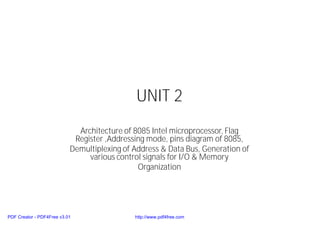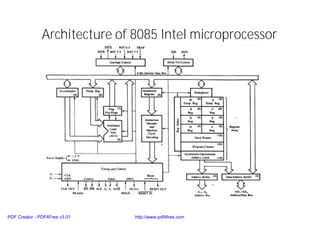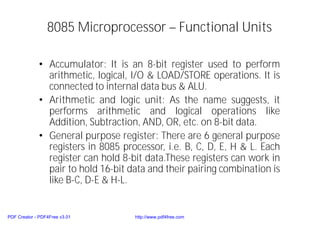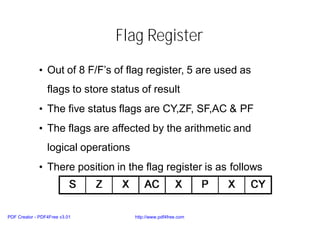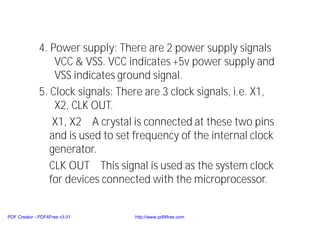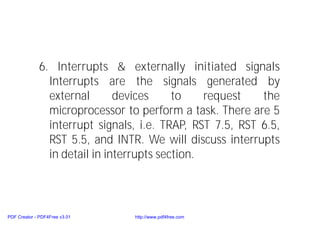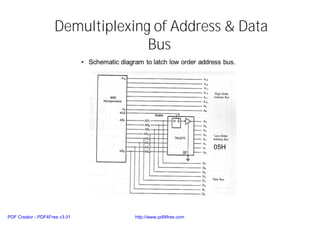Microprocessor Unit 2.PDF
- 1. UNIT 2 Architecture of 8085 Intel microprocessor, Flag Register ,Addressing mode, pins diagram of 8085, Demultiplexing of Address & Data Bus, Generation of various control signals for I/O & Memory Organization PDF Creator - PDF4Free v3.01 http://www.pdf4free.com
- 2. Architecture of 8085 Intel microprocessor PDF Creator - PDF4Free v3.01 http://www.pdf4free.com
- 3. 8085 Microprocessor â Functional Units âĒ Accumulator: It is an 8-bit register used to perform arithmetic, logical, I/O & LOAD/STORE operations. It is connected to internal data bus & ALU. âĒ Arithmetic and logic unit: As the name suggests, it performs arithmetic and logical operations like Addition, Subtraction, AND, OR, etc. on 8-bit data. âĒ General purpose register: There are 6 general purpose registers in 8085 processor, i.e. B, C, D, E, H & L. Each register can hold 8-bit data.These registers can work in pair to hold 16-bit data and their pairing combination is like B-C, D-E & H-L. PDF Creator - PDF4Free v3.01 http://www.pdf4free.com
- 4. âĒ Program counter: It is a 16-bit register used to store the memory address location of the next instruction to be executed. Microprocessor increments the program whenever an instruction is being executed, so that the program counter points to the memory address of the next instruction that is going to be executed. âĒ Stack pointer: It is also a 16-bit register works like stack, which is always incremented/decremented by 2 during push & pop operations. âĒ Temporary register: It is an 8-bit register, which holds the temporary data of arithmetic and logical operations. PDF Creator - PDF4Free v3.01 http://www.pdf4free.com
- 5. âĒ Flag register: It is an 8-bit register having five 1-bit flip-flops, which holds either 0 or 1 depending upon the result stored in the accumulator. These are the set of 5 flip- ops âĒ Sign (S) âĒ Zero (Z) âĒ Auxiliary Carry (AC) âĒ Parity (P) âĒ Carry (C) PDF Creator - PDF4Free v3.01 http://www.pdf4free.com
- 6. âĒ Instruction register and decoder: It is an 8-bit register. When an instruction is fetched from memory then it is stored in the Instruction register. Instruction decoder decodes the information present in the Instruction register. âĒ Timing and control unit: It provides timing and control signal to the microprocessor to perform operations. Following are the timing and control signals, which control external and internal circuits -Control Signals: READY, RDâ, WRâ, ALE -Status Signals: S0, S1, IO/Mâ -DMA Signals: HOLD, HLDA -RESET Signals: RESET IN, RESET OUT PDF Creator - PDF4Free v3.01 http://www.pdf4free.com
- 7. âĒ Interrupt control: As the name suggests it controls the interrupts during a process. When a microprocessor is executing a main program and whenever an interrupt occurs, the microprocessor shifts the control from the main program to process the incoming request. After the request is completed, the control goes back to the main program. There are 5 interrupt signals in 8085 microprocessor: INTR, RST 7.5, RST 6.5, RST 5.5, TRAP. âĒ Serial Input/output control: It controls the serial data communication by using these two instructions: SID (Serial input data) and SOD (Serial output data). PDF Creator - PDF4Free v3.01 http://www.pdf4free.com
- 8. âĒ Address buffer and address-data buffer: The content stored in the stack pointer and program counter is loaded into the address buffer and address-data buffer to communicate with the CPU. The memory and I/O chips are connected to these buses; the CPU can exchange the desired data with the memory and I/O chips. âĒ Address bus and data bus: Data bus carries the data to be stored. It is bidirectional, whereas address bus carries the location to where it should be stored and it is unidirectional. It is used to transfer the data & Address I/O devices. PDF Creator - PDF4Free v3.01 http://www.pdf4free.com
- 9. Flag Register âĒ Out of 8 F/Fâs of flag register, 5 are used as flags to store status of result âĒ The five status flags are CY,ZF, SF,AC & PF âĒ The flags are affected by the arithmetic and logical operations âĒ There position in the flag register is as follows PDF Creator - PDF4Free v3.01 http://www.pdf4free.com
- 10. âĒ CY (Carry flag) : If an arithmetic operation results in a carry, then CY=1 âĒ AC (Auxiliary carry) : In an arithmetic operation when carry is generated after D3 and passed to D4, the AC is set. âĒ P (Parity flag) : After an arithmetic or logical operation, if the result has an even no. of 1âs then parity flag is set. âĒ Z (Zero flag) : Zero flag is set when result of operation is zero (00H). âĒ S (Sign flag) :It is a copy of 7 bit of result. If S=1, then negative result. If S=0, then result is positive. PDF Creator - PDF4Free v3.01 http://www.pdf4free.com
- 11. Status flags affected e.g. 89H + 88H 1 0 0 0 1 0 0 1 + 1 0 0 0 1 0 0 0 âĒ 1 0 0 0 1 0 0 0 1 âĒ CY = 1,P = 1, AC = 1, Z = 0 , S = 0 âĒ Flag register contents : S Z X AC X P X CY 0 0 X 1 X 1 X 1 PDF Creator - PDF4Free v3.01 http://www.pdf4free.com
- 12. Addressing Modes of 8085 âĒ The method by which address of source of data & address of destination of result(i.e. address of operand) is given in the instruction is called as addressing mode. There are 5 types of addressing mode in up 8085 1. Immediate Addressing Mode(IAM) 2. Register Direct or Register Addressing Mode(RDAM) 3. Direct Addressing Mode(DAM) 4. Register Indirect or Indirect Addressing Mode(RIAM) 5. Implicit or Inherent Addressing Mode(IPAM) PDF Creator - PDF4Free v3.01 http://www.pdf4free.com
- 13. Immediate Addressing Mode(IAM) If 8 or 16 bit data required to execute any instruction is given directly along with the instruction as operand then such instructions are called immediate addressing mode instructions. The last alphabet in most of immediate addressing mode instruction mnemonic is I. Ex: MVI A 75H PDF Creator - PDF4Free v3.01 http://www.pdf4free.com
- 14. Register Direct or Register Addressing Mode(RDAM) If 8 or 16 bit data required to execute any instruction is present in 8/16 bit register or register pair and the name of this register or register pair containing data is given along with the instruction as operand. Such instructions are called Register Direct or Register Addressing Mode instructions. Ex. MOV A,B PDF Creator - PDF4Free v3.01 http://www.pdf4free.com
- 15. Direct Addressing Mode(DAM) If 8 or 16 bit data required to execute any instruction is present in memory location or IO port and 16 or 8 bit address of this memory location or IO port is given along with the instruction as operand then such instructions are called Direct Addressing Mode instructions. Ex. LDA 9000H PDF Creator - PDF4Free v3.01 http://www.pdf4free.com
- 16. Register Indirect or Indirect Addressing Mode(RIAM) If 8 or 16 bit data required to execute any instruction is present in memory location. The 16 bit address of this memory location is present in 16 bit register or register pair and the name of this register or register pair containing memory address is given along with the instruction as operand then such instructions are called Indirect Addressing Mode instructions. Ex. LDAX B PDF Creator - PDF4Free v3.01 http://www.pdf4free.com
- 17. Implicit or Inherent Addressing Mode(IPAM) If address of source of data as well as address of destination of result both are fixed and it is accumulator then there is no need to give any operand along with the instruction, such instructions are called Implicit addressing mode instructions Ex. CMA DAA PDF Creator - PDF4Free v3.01 http://www.pdf4free.com
- 18. Pin Diagram of 8085 PDF Creator - PDF4Free v3.01 http://www.pdf4free.com
- 19. The pins of a 8085 microprocessor can be classified into seven groups 1. Address bus: A15-A8, it carries the most significant 8-bits of memory/IO address. 2. Data bus: AD7-AD0, it carries the least significant 8-bit address and data bus. 3. Control and status signals: These signals are used to identify the nature of operation. There are 3 control signal and 3 status signals. PDF Creator - PDF4Free v3.01 http://www.pdf4free.com
- 20. Three control signals are RD, WR & ALE a. RD This signal indicates that the selected IO or memory device is to be read and is ready for accepting data available on the data bus. b. WR This signal indicates that the data on the data bus is to be written into a selected memory or IO location. c. ALE It is a positive going pulse generated when a new operation is started by the microprocessor. When the pulse goes high, it indicates address. When the pulse goes down it indicates data. Three status signals are IO/M, S0 & S1 âĒ IO/M - This signal is used to differentiate between IO and Memory operations, i.e. when it is high indicates IO operation and when it is low then it indicates memory operation. âĒ S1 & S0- These signals are used to identify the type of current operation. PDF Creator - PDF4Free v3.01 http://www.pdf4free.com
- 21. 4. Power supply: There are 2 power supply signals VCC & VSS. VCC indicates +5v power supply and VSS indicates ground signal. 5. Clock signals: There are 3 clock signals, i.e. X1, X2, CLK OUT. X1, X2 A crystal is connected at these two pins and is used to set frequency of the internal clock generator. CLK OUT This signal is used as the system clock for devices connected with the microprocessor. PDF Creator - PDF4Free v3.01 http://www.pdf4free.com
- 22. 6. Interrupts & externally initiated signals Interrupts are the signals generated by external devices to request the microprocessor to perform a task. There are 5 interrupt signals, i.e. TRAP, RST 7.5, RST 6.5, RST 5.5, and INTR. We will discuss interrupts in detail in interrupts section. PDF Creator - PDF4Free v3.01 http://www.pdf4free.com
- 23. âĒ INTA It is an interrupt acknowledgment signal. âĒ RESET IN This signal is used to reset the microprocessor by setting the program counter to zero. âĒ RESET OUT This signal is used to reset all the connected devices when the microprocessor is reset. âĒ READY This signal indicates that the device is ready to send or receive data. If READY is low, then the CPU has to wait for READY to go high. âĒ HOLD This signal indicates that another master is requesting the use of the address and data buses. âĒ HLDA (HOLD Acknowledge) It indicates that the CPU has received the HOLD request and it will relinquish the bus in the next clock cycle. HLDA is set to low after the HOLD signal is removed. PDF Creator - PDF4Free v3.01 http://www.pdf4free.com
- 24. âĒ Serial I/O signals: There are 2 serial signals, i.e. SID and SOD and these signals are used for serial communication. âĒ SOD (Serial output data line) The output SOD is set/reset as specified by the SIM instruction. âĒ SID (Serial input data line) The data on this line is loaded into accumulator whenever a RIM instruction is executed. PDF Creator - PDF4Free v3.01 http://www.pdf4free.com
- 25. Demultiplexing of Address & Data Bus PDF Creator - PDF4Free v3.01 http://www.pdf4free.com
- 26. âĒ up 8085 has 16 address pins A15-A8 and AD7- AD0. âĒ Similarly up 8085has 8 data pins AD7-AD0,as these pins are common which are used to transfer 8 LSBs of address as well as 8 bit data but at different time âĒ So AD7-AD0 pins are also called Time multiplexed or Time shared address data pins âĒ In practical system the address and data of AD7-AD0bpins are separated using external 8 bit latch(flip-flop) PDF Creator - PDF4Free v3.01 http://www.pdf4free.com
- 27. âĒ When up will transfer 16-bit address on A15-A8 and AD7-AD0 pins then at the same time up gives logic 1 pulse on ALE pin, clk=1. When ALE signal changes from 1 to 0 then 8 LSBs of address on AD7-AD0 pins get stored in 8 bit latch âĒ When up will transfer 8 bit data through AD7-AD0 pins then up gives ALE =0, clk= 0, hence 8 bit data is not stored in Latch. âĒ So complete 16 bit address is available on 16 bit address bus A15-A8 and A7-A0. âĒ At the same time 8-bit data is available on 8 bit data bus D7 to D0 PDF Creator - PDF4Free v3.01 http://www.pdf4free.com
- 28. Advantages of Common pins AD7-AD0 âĒ As address and data pins are common i.e.AD7-AD0, so number of pins of up 8085 required for address and data gets reduced Disadvantages of Common pins AD7-AD0 âĒ As AD7-AD0 are common so up has to give some time gap between address transfer and data transfer, hence up becomes slow. âĒ If address & data pins would have been separate then up can transfer address and data together in parallel so system will become fast âĒ We have to connect external 8 bit latch IC74373, so hardware increased. PDF Creator - PDF4Free v3.01 http://www.pdf4free.com
- 29. Generation of various control signals for I/O & Memory Organization âĒ To select one memory location, up will transfer 16-bit memory location address on address pins and at the same time up will transfer IO/Mâ =0. âĒ This 16 bit address with IO/Mâ=0 is used to select one memory location âĒ To select one IO port, up will transfer 8 bit address on 8 upper address line A15-A8 as well as duplicated on lower address line A7-A0. âĒ At the same time up will output IO/Mâ=1. âĒ This 8 bit I/O port address with IO/Mâ=1 is used to select one IO port PDF Creator - PDF4Free v3.01 http://www.pdf4free.com
- 30. âĒ When IO/Mâ = 1/0 then it indicates that the address on address pins is for IO port/Memory location respectively âĒ To read 8 bit data from selected memory location or selected I/O port up gives RDâ=0 otherwise RDâ=1 âĒ To store or write 8 bit data into selected memory location or IO port up gives WRâ = 0 otherwise WRâ=1 âĒ These control signals output of up i.e. IO/Mâ, RDâ, WRâ are decoded using OR-gate or using NAND gate or using 3:8 decoder to generate 4 control signals PDF Creator - PDF4Free v3.01 http://www.pdf4free.com
- 31. âĒ These 4 control signals are also given in table below Sr. No. GENERATION OF up SIGNALS OUTPUT BY up CONTROL SIGNALS GENERATED IO/Mâ RDâ WRâ MEMRâ MEMWâ IORâ IOWâ 1. up reading data from memory 0 0 1 0 1 1 1 2. up writing data into memory 0 1 0 1 0 1 1 3. up reading data from IO port 1 0 1 1 1 0 1 4. up writing data into IO port 1 1 0 1 1 1 0 PDF Creator - PDF4Free v3.01 http://www.pdf4free.com

